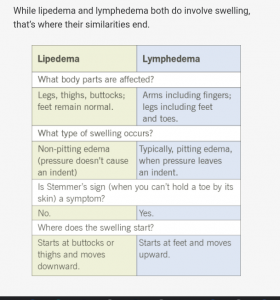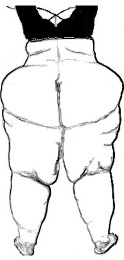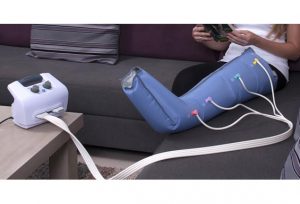Make an Appoinment
Deep Venous Thrombosis or DVT
Bedsores | Decubitus Ulcers
LIPEDEMA | Causes, Symptoms And Treatment | RUFADDAS MEDICAL
Lipedema is not a rare disease as folks often say.It is a disease that is rarely diagnosed. Doctors often mistake it for lymphedema

or regular obesity.
“Oh that’s just because of the excess fat in your body,” some doctors will say, “Try losing some weight and you will see it disappear gradually.”
But these lipedema fat don’t go away even if you lose all the fat in the world!
So here’s the thing, if you know someone who has lipedema. It is not their own doing. Although people who have lipedema are often overweight, yet it has nothing to do with regular fat.
This condition occurs exclusively in women and 11% of women all over the world have lipedema.
What is Lipedema?

In simple terms, lipedema means fluid-in the-fat. It is an irregular distribution of fat under the skin in specific areas of the body (below the waist and may extend to the arms).
This condition often leads to deformations of the body, disability and even the development of diabetes.
Causes
Since the first discovery of lipedema in the1940s, there has not been a known cause for the debilitating condition. However, scientists believe that it has to do with the gynoid hormone in women. This gynoid fat starts becoming exccessive – or worsens – in a person with lipedema around the time of her first menstruation, during pregnancy, after gynaecologic surgery, or during menopause. It is also known to be a gene related disease.
So the logic is pretty simple, anyone who has lipedema knows a family member who has lipedema. Some patients with lipedema develop secondary lymphedema, where fat cells block vessels of the lymphatic system that usually help to balance body fluid levels and protect against infections.
This blockage prevents the proper drainage of lymph fluid, which leads to a buildup of fluid called lymphedema that can cause problems like infections, delayed wound healing, development of scar like tissues called fibrosis, hardened skin in the leg growth interferes with the lymphatic system.
Symptoms
Lipedema begins by the enlargement of the upper lower half of the body and column-like legs. This means that a woman could wear a size 8 above the waist and size 16 below the waist, while the size of her leg is in line with the upper part of her body. After a while it starts to extend to the legs and may also extend to the arms.
The symptoms of lipedema change with disease progression. At advanced stages, excessive fat accumulation and progressive lymphatic system insufficiency and damage induces secondary lymphedema and fluid accumulation in the area. This combination is referred to as lipo-lymphedema.
This condition exhibits both lipedema and lower-limb lymphedema symptoms, including swelling below the ankles and in the feet, that is usually not the case with just lipedema.
Treatment
There are no treatments that cures lipedema completely but a change in lifestyle could improve the health condition of patients.
Lymphedema treatments won’t help someone with lipedema, so a correct diagnosis is crucial. Lymphedema treatments however, may also help some of the symptoms, but it still won’t resolve the lipedema.
There are lifestyle changes and treatment that a patient can adopt to improve her health condition. These includes:
Heart-healthy
Forming an habit of taking a heart-healthy diet may slow the growth of fat deposits.
Regular Exercise
Exercises like walking, swimming or biking may reduce painful symptoms.
The Use of Compression Garments
Compression garments are pieces of clothing that fit tightly around the skin. In medical contexts, compression garments provide support for people  who have to stand for long periods or have poor circulation. These tight garments can provide relief if they’re not too tight or painful to wear.
who have to stand for long periods or have poor circulation. These tight garments can provide relief if they’re not too tight or painful to wear.
Manual Lymphatic Drainage
Patients can also learn how to do manual lymphatic drainage therapy. This gentle form of skin stretching and massage may help with symptoms or help contain the fat.
Liposuction
Some doctors use a water jet to disconnect the fat and prevent damage to the lymphatic vessels, which could result in a buildup of fluid called lymphedema. Here, fat cells block vessels of the lymphatic system that usually help to balance body fluid levels and protect against infections. The blockage prevents the proper drainage of lymph fluid. This can cause problems like infections, delayed wound healing, development of scar like tissues called fibrosis, hardened skin in the leg.
There are other types of liposuction that might work as well.
If you are dealing with lipedema, or you know someone who is, we strongly advice that you try not to be intimidated by a dismissive doctor. Chances are, the doctor simply doesn’t know what lipedema is. It helps to adopt a change in lifestyle of regular intake of heart-healthy foods as well as other lifestyle changes and treatment prescribed above.
Rufaddas Medical is a major supplier of Phlebo Press® DVT systems by Mego Afek as well as compression stockings. Phlebo Press® DVT systems is the ultimate leg pressure therapy. deliver the “gold standard” of pneumatic compression therapy-gradient, sequential, circumferential compression – with precise, calibrated pressure profiles and timings that have been clinically proven most effective for maximum increase of venous blood flow volume and velocity in the deep veins of the legs. A variety of garment configurations are available: thigh length, knee length, foot only, and our proprietary foot-calf design.
Was this article helpful?
Get your compression stockings, DVT line and other quality medical equipment and hospital supplies at affordable prices here at Rufaddas Nigeria Limited. The home of quality medical equipment. We deliver nationwide | Order Now.
Our store locations are Lagos and Ibadan, Nigeria. And yes, we deliver nationwide.
For Enquiries:
Kindly Call
Adelola +234 816 561 9521
Sunday +234 806 034 7394
Rufaddas Medical…Affordable Quality Medical Supplies
Visit Us
Suite 41, Aderonke Plaza, 20 Olowu St, Ikeja
rufaddasngltd@gmail.com
WhatsApp us